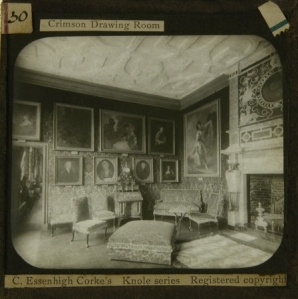Knole is an ancient place. Layers of history are contained within its walls. As a curator, I am fascinated by the material evidence of the past and the lives that shaped the place we experience today. My favourite object at Knole is always what ever I happen to be standing next to when I am asked.
At the moment I am trying to understand how some of the spaces that have been open to visitors for many years have changes and why. On my desk is a copy of the 1906 Knole guide book written by Lionel Sackville-West. It is a lovely book, bound in red with heraldic symbols embossed in gold on the front and it is heavy too. Inside is a history of the Sackville family and a guide to the house and park.
It is full of illustrations and photographs by Charles Essenhigh Corke (1852-1922). He was a painter and photographer who was effectively artist-in-residence at Knole during the first decade of the twentieth century. His paintings have a romantic quality in their colour and tone and when he paints a room, light is always cast through it as if it is perhaps a late summer afternoon. This amuses me as Knole is actually quite a cold draughty place most of the time.
We also have a box of Charles Essenhigh Corke’s lantern slides in the collection at Knole. I like them because we can look through his eyes to the house and park as it was over 100 years ago. They are interesting because they represent such old photographic technology and they are so fragile; images printed on glass which could easily be broken and lost.
The photographs contain all kinds of useful information. If you compare a picture of the Reynolds Room at Knole today with Essenhigh Corke’s photograph you can see from the label that the name of the room has changed, that furniture has moved or disappeared and that some of the paintings are different too. It is a piece of detective work to understand where things have gone. The portrait of Giovanna Baccelli by Thomas Gainsborough next to the fireplace is now in the collections at the Tate. The guide book and photographs are as close as I can get to a time machine!

The interior of the Reynolds Room at Knole today. It is also known as the Crimson Drawing Room due to the fact that its walls are hung with a rare early 18th Century crimson stamped woollen velvet.
Emma






Pingback: Charles Essenhigh Corke | Parks and Gardens UK